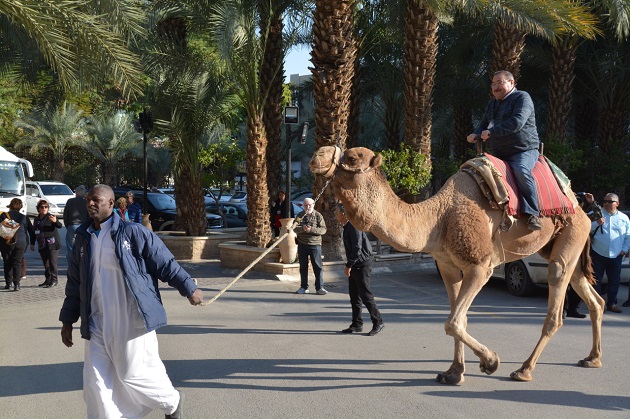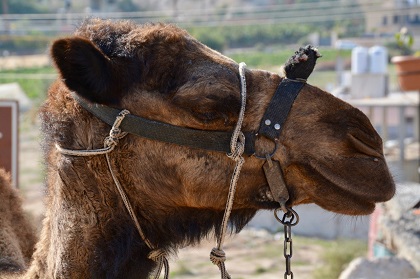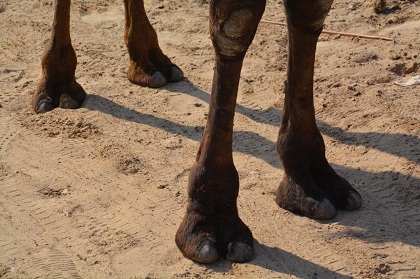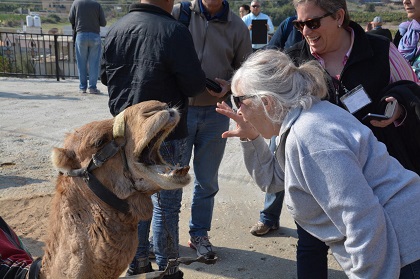Dromedary camels and tourists in the Holy Land
They are ruminating animals, capable of running more than one hundred kilometres a day without eating or drinking anything. Hence they were trained in Arabia in the 13th century before Christ, as the basis of what has come to be known as the "camel civilisations".
18 JUNE 2017 · 10:00 CET

The camel (Camelus bactrianus) and the dromedary (Camelus dromedarius) are two animals that have been used very extensively as a means of transport since remote antiquity. Without them, the development of crucially important trade routes would have been impossible. However, they are two members of the camelidae family that are easily confused. Let's consider some of the differences between them.
In the first place, the dromedary, or single-hump camelid, originated in the Arabian Peninsula, where it is capable of withstanding temperatures of more than 50ºC. The two humped camel, by contrast comes from central Asia, where it has adapted to the long cold winter climates that are common in the Gobi desert.

The most visible physical feature that distinguishes them is undoubtedly their humps. Dromedaries only have one while camels have two. These humps consist mainly of fatty tissue, which provides them with the energy they need to cross inhospitable deserts, where food is extremely scarce. Besides, they protect them from excessive heat-loss during the night, or when the temperatures plummet. Hence the fact that the camel, which inhabits colder regions, has two humps.
Also in relation to their habits is the fact that these resilient animals have different types of skin. Camels have long hair, which becomes thick in winter, and molts in summer, while the dromedary's hair remains short all year round, enabling it to dissipate the heat more effectively.

Camels are smaller, more robust and heavier than dromedaries, their legs are shorter and well-suited to the frozen mountainous terrain, while the dromedaries are slimmer, and their long legs mean that they can raise their bodies high above the burning sands of the desert dunes. This adaptation means that they are protected from the intense heat and thus can travel more quickly.
Although the Bible mentions both camels and dromedaries (Isaiah 60:6), in fact it is the latter that appear more often. They are ruminating animals, capable of running more than one hundred kilometres a day without eating or drinking anything. Hence they were trained in Arabia in the 13th century before Christ, as the basis of what has come to be known as the "camel civilisations".
Their long legs were perfectly designed to walk across the desert sand. They only have two toes, with nails, joined by a hoofpad. Under their belly they have aquiferous cells which constitute a reserve of metabolic water.
The dromedary's character is quite unpredictable. It is prone to outbursts of anger. It can be disturbed by any unforeseen noise, such as the screech of a bird. It also doesn't easily forget a grievance, and tends to be vindictive. It has even been known to bite its owner, or throw a whole caravan into chaos when it loses its temper. Despite all that, the benefits it brings to human beings outweigh the inconveniences caused by its changeable temperament. Although the Israelites were forbidden to eat its meat (Lv. 11: 4; Dt. 14: 7), Arabs could eat it. Its hide was used to make tents and clothing. Even camel milk was part of the Bedouins' staple diet.
The Old Testament Patriarchs used dromedaries or Arabian camels especially. Abraham and Jacob owned many of them (Gn. 12: 16; 30: 43). The Ishmaelites who took Joseph to Egypt used these animals to do so (Gn, 37:25). Rebecca was riding one of them when she rode out to meet Isaac (Gn 24:64). The Midianites and other peoples used them for military purposes (Judges 6:5). Nevertheless, after the conquest of Canaan, it seems that the Hebrews had little use for dromedaries, as they had no further need to travel.
In the New Testament, the Lord Jesus refers to camels on a number of occasions to highlight the impossibility of certain things: "It is easier for a camel to go through the eye of a needle than for a rich man to enter the kingdom of God" (Mt. 19:24); and also the hypocrisy of the Pharisees: "Blind guides, straining at a gnat and swallowing a camel!" (Mt. 23:24).

I took these photographs of dromedaries in Jericho, where they still represent an important source of revenue for their Palestinian owners, as they offer fleeting camel-rides to smiling, satisfied tourists.
Published in: Evangelical Focus - Zoe - Dromedary camels and tourists in the Holy Land
